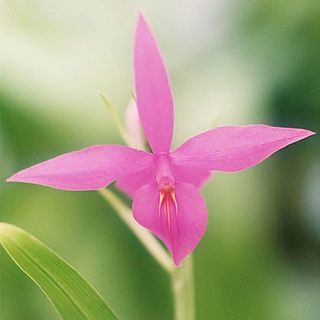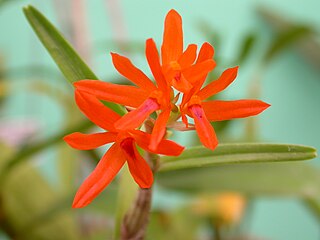
Sobralia is a genus of orchids native to Mexico, Central and South America. The plants are more commonly terrestrial, but are also found growing epiphytically, in wet forests from sea level to about 8,800 ft. The genus was named for Dr. Francisco Sobral, a Spanish botanist. The genus is abbreviated Sob in trade journals.

Epidendrum, abbreviated Epi in the horticultural trade, is a large neotropical genus of the orchid family. With more than 1,500 species, some authors describe it as a mega-genus. The genus name refers to its epiphytic growth habit.
Schomburgkia was a genus of plants belonging to the family Orchidaceae. This genus was named for Richard Schomburgk, a German botanist who explored British Guiana during the 19th century. Former species of this genus were either epiphytic or lithophytic in their growth habit. According to the Royal Horticultural Society Schom. was the official abbreviation for this genus.

Within the Orchidaceae, Hormidium was originally a subgenus of the genus Epidendrum, but was later raised to a full genus. It is now considered not to be distinct from the genus Prosthechea, of which it is a synonym. Most of the species of Hormidium have been transferred to Prosthechea, although others are now classified in Encyclia, Epidendrum, Homalopetalum, and Lepanthes.

Barkeria, abbreviated Bark in horticultural trade, is a genus of orchids. It consists of about 17 currently recognized species native to Mexico and Central America. This genus was once considered part of Epidendrum. Type species is Barkeria elegans; this is now considered a synonym of B. uniflora yet retains its status as type per ICN.

Barbosella is a genus of mostly creeping orchids. The genus has about 20 species, widespread across the West Indies and Latin America from Mexico and the Lesser Antilles to Argentina. Named after João Barbosa Rodrigues, an investigator of Brazilian orchids. They have solitary flowers with a unique lip base that works like a ball and socket.

Laeliinae is a Neotropical subtribe including 40 orchid genera, such as Brassavola, Laelia and Cattleya. The genus Epidendrum is the largest within this subtribe, containing about 1500 species. This is followed by the genus Encyclia, with over 120 species.

Mormodes, abbreviated as Morm. in the horticultural trade, is a genus of approximately 70-80 species of terrestrial and epiphytic orchids native to Mexico, Central America and South America.

Notylia, abbreviated Ntl in horticultural trade, is a genus of orchids. It consists of 56 recognized species, native to Mexico, Central America, Trinidad and South America.

Epidendrum secundum, one of the crucifix orchids, is a poorly understood reed stemmed species, which Dressler (1989) describes as "the Epidendrum secundum complex." According to Dressler, there are dozens of varieties, some of which appear to deserve species rank. Arditti and Ghani note that E. secundum has the distinction of bearing the longest seeds known in the Orchidaceae, 6.0 mm long. By comparison, the seeds of E. ibaguense are only 2.9 mm long.

Scaphyglottis is a genus of orchids native to Mexico, Central America, northern South America and parts of the Caribbean. The current concept of this genus is the result of combining several genera which have been described at various times. The concept is characterized by the growth habit: not only are new pseudobulbs added at the base of the old ones, but new pseudobulbs also grow at the apices of the old ones. Many species are quite similar and difficult to distinguish, but some are clearly distinct. A few have showy colors. The genus comprises nearly 70 species.

Encyclia ceratistes, also known as Epidendrum ramonense or frosted rain, is a species of orchid. It is found in southeast and southwest Mexico, Central America and the northern parts of South America. E. ceratistes prefers hot-to-cool oak and mixed hardwood forests at 330 to 1600 m in elevation.

Encyclia oncidioides is a species of orchid. The diploid chromosome number of E. oncidioides has been determined as 2n = 40.

Eulophia speciosa is a species of terrestrial orchid found from Ethiopia to South Africa and in Yemen and Saudi Arabia. The plants usually grow in grasslands in sandy soils or in clay.

Epidendrum ibaguense is a species of epiphytic orchid of the genus Epidendrum which occurs in Trinidad, French Guiana, Venezuela, Colombia and Northern Brazil.
This page is based on this
Wikipedia article Text is available under the
CC BY-SA 4.0 license; additional terms may apply.
Images, videos and audio are available under their respective licenses.
























